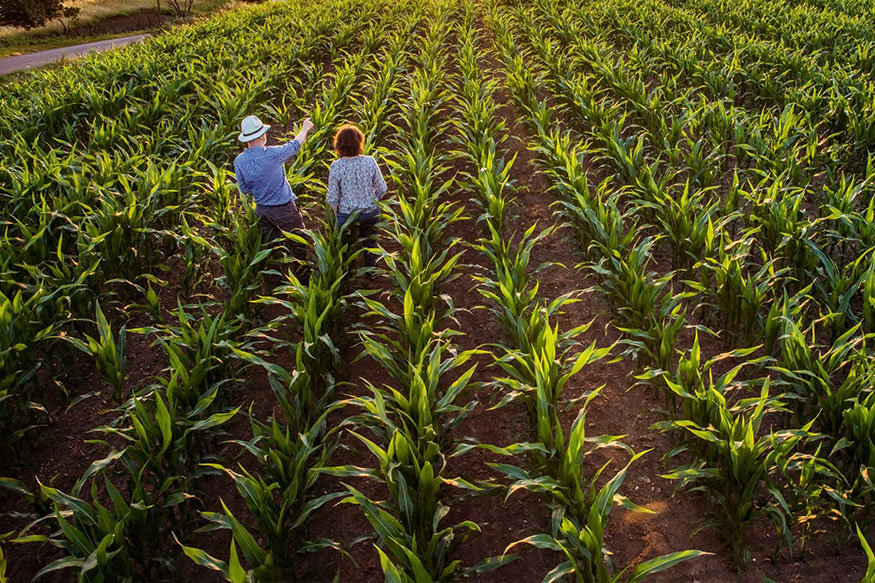(This page focuses on farmers who grow fruits and/or vegetables to sell. If you are a home gardener or hobby farmer, go here to learn how to grow safe food in your garden.)
Produce Safety and Good Agricultural Practices (GAP)
Fruits and vegetables continue to be associated with foodborne illness outbreaks, including, but not limited to lettuce, spinach, cantaloupe, tomatoes, cilantro, and green onions.
Using good agricultural practices (GAP) is one way farmers and growers can reduce the risk of microbial contamination of the fruits and vegetables they produce. GAP programs address the safety of water, manure use, sanitation, and personal hygiene practices on the farm, in the field, during harvest, packing, and transportation. This voluntary program through USDA conducts an audit on a farm operation to check for these basic practices. Our training program will help you prepare for a GAP audit and continue producing high-quality products using the best food safety standards. Visit https://www.ams.usda.gov/services/auditing/gap-ghp for more information on the GAP program and various components.
Resources and Tools
- Worker health and hygiene
- Wildlife and domestic animals
- Biological soil amendments
- Harvest Activities
- Agricultural water: Production, Harvest and Post-harvest
- Post-harvest handling
- Writing a food safety plan
- Traceability programs
- Worker training resources
Food Safety Modernization Act: Produce Safety Rule
The Produce Safety Rule of the Food Safety Modernization Act (FSMA) outlines science-based minimum standards for the safe growing, harvesting, packing, and holding of fresh fruits and vegetables. In Connecticut, the compliance activities related to the Rule are the jurisdiction of the Connecticut Department of Agriculture (DoAg). Farmers preparing to comply with the Rule, and/or choosing to make safe production and handling a business priority may want to:
- Learn how the rule is being implementated in Connecticut.
- Learn more about the Rule including coverage, exemptions, compliance, FDA guidance documents, Record/documentation requirements.
- Learn more about Food Safety Standards addressed in the Rule.
- Attend the Produce Safety Alliance Grower Training course.
- Participate in an On Farm Readiness Review (OFRR) or other one-on-one informational visit from UConn Extension personnel.
- Participate in Market Access and Audit Programs for certain buyers of fresh produce, such as the Connecticut GAP or CGAP program of the Connecticut Department of Agriculture or other third party audit programs. Produce Safety Rule Inspections compared with Audit Programs (PDF)
- Use tools for meeting Rule standards, implementing good agriculture practices (GAP), writing food safety plans and developing traceback programs.
- Check out the FDA Small Entity Compliance Guidance Document for the Produce Safety Rule:

IMPORTANT UPDATES
The FDA has finalized revisions to Subpart E (Water rule requirements). There are significant changes in the new water rule requirements including requirements for systems-based pre-harvest agricultural water assessments. To read more about the new rule on the FDA website.
Visit our Agricultural Water page to find resources for compliance with all of the agricultural water provisions in the Produce Safety Rule.
Sign up here to be added to our Produce Safety mailing list - be informed about the Produce Safety Rule, produce safety issues, GAP audits and programs, updates, and more.
Funding for this section of our website was made possible, in part, by the Food and Drug Administration through grant PAR-16-137. The views expressed in written materials or publications do not necessarily reflect the official policies of the Department of Health and Human Services; nor does any mention of trade names, commercial practices, or organization imply endorsement by the United Stated Government.
Contacts
Indu Upadhyaya, DVM, MVSc, PhD
Cell: 860-786-8191 (preferred)
Phone: 860-871-0776
Email: indu.upadhyaya@uconn.edu
CT Department of Agriculture
Fruit & Vegetable Inspection Programs
Phone: 860-713-2522
Email: ProduceSafety@ct.gov
Farm worker training: A day in the life of a farm worker: Part l: Safe Harvesting Practices
Capacitación de Trabajadores Agrícolas – Prácticas de Cosecha Segura
Farm worker training: A day in the life of a farm worker: Part II: Safe Post-harvest Practices
Capacitación de Trabajadores Agrícolas | Prácticas Seguras de Poscosecha
This website is supported by the Food and Drug Administration (FDA) of the U.S. Department of Health and Human Services (HHS) as part of a financial assistance award totaling $69,364 with 10 percent funded by FDA/HHS and the rest amount and 90 percentage funded by non-government source(s). The contents are those of the author(s) and do not necessarily represent the official views of, nor an endorsement, by FDA/HHS, or the U.S. Government.